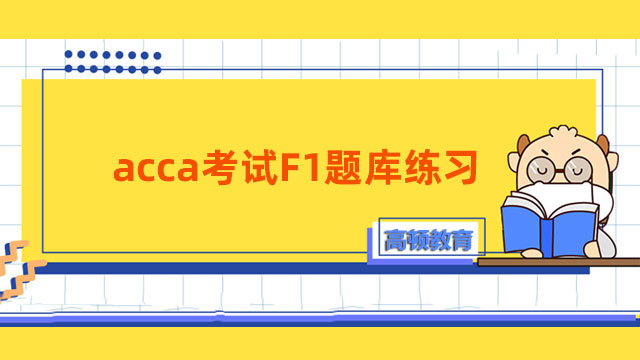ACCA考试P1-P3模拟题及解析10
来源:
高顿网校
2014-07-17
以下是高顿网校小编为学员整理的:ACCA P1-P3模拟题及解析。
Emile Gonzalez is an industrial chemist who worked for the government of Pablos for more than 20 years. In his spare time, he continually experimented with formulating a product that could remove graffiti from all surfaces. Graffiti is a particular problem in Pablos and all previous removal methods were expensive, dangerous to apply and did not work on all surfaces. After many years of experimentation, Emile formulated a product that addressed all these issues. His product can be applied safely without protective clothing, it removes graffiti from all surfaces and it can be produced economically in small, as well as large, volumes.
Three years ago, Emile left his government job to focus on refining the product and bringing it to market. He formed a limited liability company, Graffoff, with initial share capital funded by his savings, his family’s savings and a legacy from a wealthy relative. He is the sole shareholder in the company, which is based in a factory in central Pablos. The company has filed two years of results (see Figure 1 for extracted information from year (2), and it is expected to return similar net profit figures in its third trading year. Emile takes a significant dividend out of he company each year and he wishes that to continue. He also wishes to remain the sole owner of the company.
Four years ago, Emile was granted a patent for the formula on which his product is based and a further patent on the process used to produce the product. In Pablos, patents are protected for ten years and so Emile has six further years before his formula becomes available to his competitors. Consequently, he wants to rapidly expand the company and plans to lease premises to create 30 new graffiti removal depots in Pablos, each of which will supply graffiti removing services in its local region. He needs $500,000 to finance this organic growth of his company.
Emile does have mixed feelings about his proposed expansion plan. Despite the apparent success of his company, he prefers working in the laboratory to managing people. ‘I am just not a people person’, he has commented. He is aware that he lacks business experience and, despite the technical excellence of the product, he has failed to build a highly visible brand. He also has particular problems in the accounts receivables department, where he has failed to address the problems of over-worked and demotivated employees. Emile dislikes conflict with customers and so he often offers them extended payment terms to the dismay of the accounts receivables section, who feel that their debt collecting effectiveness is being constantly undermined by his concessions. In contrast, Graffoff pays bills very promptly, due to a zealous administrator in accounts payable who likes to reduce creditors. Emile is sanguine about this. ‘I guess we have the money, so I suppose we should pay them.’
In Pablos, all goods are supplied to customers on 30 days credit. However, in the services sector that Graffoff is trading in, the average settlement period for payables (creditors) is 40 days. One supplier commented that ‘Graffoff is unique in its punctuality of payment.’
Emile is currently reviewing how to finance his proposed organic growth. He is unwilling to take on any further external debt and consequently he has also recently considered franchising as an alternative to organic growth. In his proposed arrangement, franchisees would have responsibility for leasing or buying premises to a specification defined in the franchise agreement. The franchise would have exclusive rights to the Graffoff product in a defined geographical region.
The Equipment Emporium has 57 superstores throughout the country selling tools and machines such as air compressors, generators and ventilation systems. It is a well-recognised brand with a strong marketing presence. It focuses on selling specialist products in bright, well-lit superstores. It has approached Graffoff to ask whether it can sell the Graffoff product through its superstores. Emile has rejected this suggestion because he feels that his product requires proper training if it is to be used efficiently and safely. He sees Graffoff as offering a complete service (graffiti removal), not just a product (graffiti removal equipment) and so selling through The Equipment mporium would be inappropriate.
Figure 1: Extracted financial data for Graffoff’s second year of trading, reported at 31 December 2011 Extract from the statement of financial position: Extracts from the income statement:
as at 31 December 2011 as at 31 December 2011
All figures in $000: All figures in $000
ASSETS Revenue 1,600
Non-current assets Cost of sales (1,375)
Property, plant and equipment 1,385 Gross profit 225
Intangible assets 100 Administrative expenses (100)
––––––
Total non-current assets 1,485 Finance costs (15)
Current assets Profit before tax 110
Inventories 100 Income tax expense (20)
Trade receivables 260 Profit for the period 90
Cash and cash equivalents 30
––––––
Total current assets 390
––––––
Total assets 1,875
––––––
EQUITY AND LIABILITIES
Share capital 1,500
Retained earnings 30
––––––
Total equity 1,530
Non-current liabilities
Long-term borrowings 250
––––––
Total non-current liabilities 250
Current liabilities
Trade and other payables 75
Current tax payable 20
––––––
Total current liabilities 95
Total liabilities 345
––––––
Total equity and liabilities 1,875
––––––
Required:
(a) Evaluate the franchising option being considered by Graffoff, highlighting the advantages and disadvantages of this approach from Emile’s perspective. (10 marks)
(b) Johnson, Scholes and Whittington have identified franchising as a form of strategic alliance.
Evaluate how other forms of strategic alliance might be appropriate approaches to strategy development at Graffoff. (7 marks)
(c) A consultant has suggested that Graffoff should be able to completely fund its proposed organic expansion (at a cost of $500,000) through internally generated sources of finance.
Evaluate this claim. (8 marks)(25 marks)
Answer:
(a) Johnson and Scholes have identified franchising as a form of strategic alliance in their classification of methods of strategy development. In this approach, franchises are independently run businesses that would enter into a licence agreement with Graffoff to purchase training, equipment and materials in return for an exclusive geographical franchise area. The proposal is
that the franchisee would buy or lease appropriate premises, not Graffoff as in Emile’s organic expansion plan. Most franchises are required to make a large up-front payment, which would provide Emile with significant funds for investment or, indeed,for further dividend payments. There are also a number of avoided costs as franchisees usually pay for all the operating costs of the franchise.
Running their own business is usually sufficient to motivate the franchise owners and the motivation of any staff they employ is also their responsibility. Emile has already acknowledged that he is not a people person and so franchising neatly sub-contracts this issue. Thus, Emile could continue running Graffoff more or less as it is currently and he would avoid the problem of raising significant finance and managing a difficult period of expansion.
However, it is possible (but not inevitable) that the long-term returns to Graffoff might be lower than through directly owned or leased depots. Franchisees will take most of the profits and Graffoff will be dependent for income from materials supply and, usually, from a relatively small percentage of the franchise’s annual sales specified in the licence contract. There are also important issues to consider in the appropriate selection and control of franchises. Although the initial fee will be received by Graffoff irrespective of the franchise’s success, continuing income (and brand awareness) is dependent upon the success of the franchise. Graffoff has no experience in selecting appropriate franchisees, neither is there any evidence that it has systems in place to control quality and audit performance. These would be needed to ensure that the product is being used correctly and that the correct percentage of sales is being paid to Graffoff. Such systems will need investment and development and need to be in place before the franchise scheme is launched.
Furthermore, the success of franchises is often determined by the visibility of the brand. Emile himself recognises that Graffoff has a very low profile and he acknowledges that he has very little expertise in this area. Also, it would be obvious to potential franchisees that it may be difficult to maintain sales volumes once the patent has expired. Thus, there may be problems in attracting franchisees, particularly those willing to invest a significant amount for a product which, they may consider, has a relatively short lifetime and whose brand awareness is low. Emile could address the first of these issues by employing marketing expertise and launching vigorous campaigns. He might also address the patent issue by looking at improving the product. Thus focusing on product development (what he is good at) and not business expansion, where he has little experience and interest.
Although franchising appears to reduce financial risk, it is unlikely to produce the financial returns as quickly as the internal growth option. Emile must not underestimate the time taken to draw up the licence agreement, develop systems to support the franchise and recruit and appoint franchisees. He must also accept that some franchises are likely to fail and that returns will be low in the early years of operation as the fledgling franchises seek to establish themselves as viable independent companies.
(b) Tutorial note: There are a range of strategic alliances that the candidate might consider. Two are explicitly evaluated in the model answer. However, appropriate alternatives will be given credit.
Strategic alliances take place where two or more organisations share resources and activities to pursue a strategy. Many organisations recognise that they need to acquire materials, skills, innovation, finance or access to markets, and increasingly recognise that these may be more readily obtained through cooperation rather than ownership. The franchising option is a type of alliance, and Emile sees it as a way of funding his expansion without incurring employee motivational and management issues that he is not confident in addressing.
In terms of Graffoff, the motivation for an alliance is likely to be co-specialisation, where each partner concentrates on activities that best match their capabilities. Graffoff specialises in product design and product development. Its weaknesses,in the context of the planned expansion, appear to lie in marketing, retail and finance. Franchising has already been considered as a type of alliance. Another type of alliance that Emile might consider is a joint venture, where a new
organisation is set up jointly owned by its parents. It is often used by companies to enter a new geographical market where one of the companies provides the expertise and the other local knowledge and labour. This is not the case here, where expansion is within the country. Furthermore, there is no obvious candidate for a joint venture and, even if a partner could be found, it would take time to establish a contractual relationship. Emile, as an entrepreneur, might also find it difficult to work within a framework of a joint venture where he would need to cede a certain amount of control.
In a network arrangement, two or more organisations work in collaboration without a formal relationship. The Equipment Emporium already has 57 superstores in the country selling tools and machines. Emile rebuffed their initial advance offering to sell his product in the store, because of the need for mandatory product training. However, he might return to them and offer to set up small in-store outlets where his product could be demonstrated and its services sold. The Equipment Emporium would be paid a fee, but such an approach would, in essence, be the same as his organic growth plan but without the need for large scale capital investment. Furthermore, the locations already exist and are backed up by significant marketing expertise and high brand awareness. This kind of opportunistic alliance is a quick way of achieving the expansion that Emile requires and it draws on both partners’ expertise. There is a concern in such a loose arrangement that one partner might steal the other’s ideas or products, but that seems unlikely here. Graffoff is not interested in becoming a general machine superstore and The Equipment Emporium is primarily focused on products not services. From Emile’s perspective, this opportunistic alliance provides a potential way of piloting his proposed organic growth expansion strategy before moving into dedicated premises or, indeed, offering the outlets to franchisees.
(c) The consultant has suggested to Emile, that the company has internal sources of finance it can exploit to fully meet its required funding for organic growth. Typical sources of internal finance are retained profits, tighter credit control, reduced inventory and delayed payment to creditors. Given that Emile is committed to high dividend payments and that no information is given about inventory, two of these are relevant here.
Tightening up credit control makes it possible to release money for funding. The average settlement period for receivables can be calculated as (trade receivables/sales revenue) x 365. For the second year trading this is (260/1,600) x 365 = 59 (59·31)days. Thus, customers take, on average, 59 days to pay their debts, despite agreeing to a 30 day payment term.
Reducing this to the agreed 30 days would realise about $128,500, which could be used to invest in the business. Reducing it to 40 days (the sector-wide standard) would realise approximately $84,500.
However, these gains would only be achieved through implementing better procedures in accounts receivable. Emile realizes that this section is poorly motivated and under-staffed. Thus some of the proposed savings may be offset by increased staffing costs. He is also very sensitive to upsetting his customers and so the need to strictly adhere to payment terms may create initial difficulties and strain customer relations. He will have to refrain, in future, from intervening in the debt collection process, and not offer the generous terms of payment that currently undermine the debt collection efforts of the accounts receivable department.
This approach might be allied to delaying payments to creditors. Given the limited information, a crude estimate of the average settlement period for payables (creditors) can be calculated by (trade payables/cost of sales) x 365. In this instance this is (75/1,375) x 365 = 20 (19·91) days. Thus Graffoff pays its creditors within 20 days, whilst 40 days is common in this sector. Bringing the company in line with this practice would realise up to a further $75,500 which again could be used for investment.
There is no suggestion that this will cause a problem. The current fast payment of invoices seems to reflect the zeal of the administrator in accounts payable, rather than any policy of the company. If Graffoff elects to pay within 30 days (the normal credit terms for the country), this will still realise about $38,000.
This means that up to approximately $204,000 could be raised by Graffoff if customers adhered to payment terms and suppliers accepted sector-wide practice. This would result in a short-term, one-off acceleration of cash inflow.
Finally, the acknowledged problems with credit control might also cause Emile to consider factoring the company invoices.
Debt factoring involves a third party taking over the businesses debt collection. Most factoring companies are willing to pay 80% of approved trade receivables in advance. At current values, this should lead to an immediate cash input of $208,000 and this might be an attractive alternative to trying to manage receivables internally. It might also address the problems of motivation and staffing in the accounts receivables section. Factoring might be very valuable in a period of expansion,improving cash flow and removing, from the company, responsibility for credit investigation and debt chasing.
Whichever options are chosen, internal finance resources cannot completely raise the $500,000 required for the organic growth plan and so the consultant is incorrect in his assertion. Emile would have to seek external sources of finance to make up the shortfall. However, the amount raised through internal sources may be sufficient to effectively finance either the franchising option or the building of an opportunistic alliance with The Equipment Emporium.
高顿网校小编寄语:希望大家继续努力!打赢ACCA这场仗!

扫一扫微信,*9时间获取2014年ACCA考试报名时间和考试时间提醒
高顿网校特别提醒:已经报名2014年ACCA考试的考生可按照复习计划有效进行!另外,高顿网校2014年ACCA考试辅导高清课程已经开通,通过针对性地讲解、训练、答疑、模考,对学习过程进行全程跟踪、分析、指导,可以帮助考生全面提升备考效果。
报考指南:2014年ACCA考试备考指南
免费题库:2014年ACCA考试免费题库
考前冲刺:ACCA备考秘籍
高清网课:ACCA考试网络课程
报考指南:2014年ACCA考试备考指南
免费题库:2014年ACCA考试免费题库
考前冲刺:ACCA备考秘籍
高清网课:ACCA考试网络课程
版权声明:本条内容自发布之日起,有效期为一个月。凡本网站注明“来源高顿教育”或“来源高顿网校”或“来源高顿”的所有作品,均为本网站合法拥有版权的作品,未经本网站授权,任何媒体、网站、个人不得转载、链接、转帖或以其他方式使用。
经本网站合法授权的,应在授权范围内使用,且使用时必须注明“来源高顿教育”或“来源高顿网校”或“来源高顿”,并不得对作品中出现的“高顿”字样进行删减、替换等。违反上述声明者,本网站将依法追究其法律责任。
本网站的部分资料转载自互联网,均尽力标明作者和出处。本网站转载的目的在于传递更多信息,并不意味着赞同其观点或证实其描述,本网站不对其真实性负责。
如您认为本网站刊载作品涉及版权等问题,请与本网站联系(邮箱fawu@gaodun.com,电话:021-31587497),本网站核实确认后会尽快予以处理。
点一下领资料
【整理版】ACCA各科目历年真题
真题高频考点,刷题全靠这份资料
下载合集
acca全科学习思维导图
梳理核心考点,一图看懂全部章节
下载合集
2023年acca考纲解析
覆盖科目重难点,备考按照计划走
下载合集
acca备考 热门问题解答
- acca考试怎么搭配科目?
-
建议优先选择相关联的科目进行搭配报考,这样可以提高备考效率,减轻备考压力,1、F1-F4:为随时机考科目,难度较低,这里可以自行随意选择考试顺序。2、F5-F9:如果你的工作的和财务会计或者审计有关、或者你比较擅长财务和审计的话,推荐先考F7和F8。你可以选择一起考ACCA考试科目F7和F8或者先考F7(8)再考F8(7),这就要取决你一次想考几门。3、P阶段:选修科目中,建议企业首选AFM!第二部分科目进行选择,如果AA和SBR掌握学生更好,可以通过选择AAA,如果SBL掌握的好,可以自己选择APM。
- acca一共几门几年考完?
-
acca一共有15门考试科目,其中有必修科目和选修科目,考生需要考完13门科目才能拿下证书。
- acca一年考几次?
-
acca一年有4次考试,分别是3月、6月、9月和12月,分季机考科目是采取的这类四个考季的模式,而随时机考则是没有这方面的时间规定限制,可以随报随考。
- acca的含金量如何?
-
ACCA证书的含金量是比较高的,从就业、能力提升、全球认可等角度来说,都是比较有优势的证书,其含金量主要表现在以下几个方面:1、国际化,认可度高;2、岗位多,就业前景好;3、缺口大,人才激励。
严选名师 全流程服务
其他人还搜了
热门推荐
-
acca考试F1题库练习,考生必备! 2023-03-20
-
acca2022真题下载流程介绍,必做考前模考题! 2023-02-24
-
ACCA试卷出题形式?ACCA考试最快多久能通过? 2021-07-24
-
ACCA官方样题 F4(ENG) F8 2021-01-07
-
ACCA考试P1-P3模拟题及解析9 2021-01-07
-
四大会计事务所2017年终精华会评(中) 2018-02-01
-
2016年ACCA F1模拟练习题及答案 2016-02-29
-
2016年ACCA F8每日一练:Professional ethics 2016-01-26
-
2016ACCA考试F8自测题:Corporate governance 2016-01-26
-
关于ACCA考试P7中的专业和道德问题 2015-11-24
-
ACCA P5精选模拟题之战略性绩效考核 2015-10-10
-
ACCA F9模拟测试题之投资评估 2015-10-10
-
ACCA P3精选练习题之战略管理和组织变革 2015-10-10
-
2014年ACCA《公司法与商法》真题及答案七 2015-07-20
-
2014年ACCA《公司法与商法》真题及答案七 2015-07-20
-
2014年ACCA《公司法与商法》真题及答案六 2015-07-20
-
2014年ACCA《公司法与商法》真题及答案五 2015-07-20
-
2014年ACCA《公司法与商法》真题及答案四 2015-07-20
-
2014年ACCA《公司法与商法》真题及答案三 2015-07-20
-
2014年ACCA《公司法与商法》真题及答案二 2015-07-20
-
2014年ACCA《公司法与商法》真题及答案一 2015-07-20
-
2014年ACCA《公司法与商法》真题及答案八 2015-07-20
-
2015年ACCA考试模拟题 2015-06-26
-
2015年ACCA考试精选测试题汇总 2015-06-19
-
2015年ACCA考试《财务成本管理》模拟题汇总 2015-06-18
-
2015年ACCA考试F8模拟试题:Financial Management 2015-06-18
-
ACCA考试2015年《财务成本管理》模拟练习汇总 2015-04-27
-
ACCA考试2015年《财务成本管理》模拟练习5 2015-04-27
-
ACCA考试2015年《财务成本管理》模拟练习4 2015-04-27
 更多服务
更多服务

















